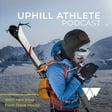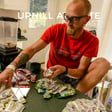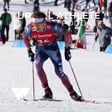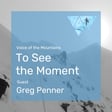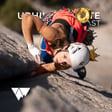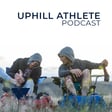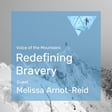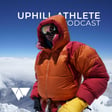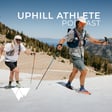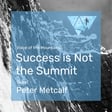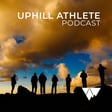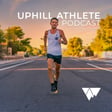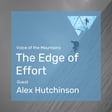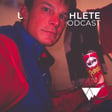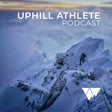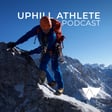Become a Creator today!Start creating today - Share your story with the world!
Start for free
00:00:00
00:00:01

Free Speed: A Talk With Coach Scott Semple
People often gloss over technique and attitude because this is in some ways more difficult to work and less gratifying than getting destroyed in a workout.
Coach Scott Semple and Uphill Athlete co-founder Scott Johnston will dive into what works, and what doesn’t.
Transcript
Introduction and Background
00:00:01
Speaker
Welcome, everybody. Thanks a lot for attending another uphill athlete Zoom conference call with everybody. Today is I'm going to be talking with my fellow coach and previous climbing partner, Scott Semple, and we've got a few topics we wanted to discuss. I want to start the conversation with the introduction of Scott and give people some background on how we know each other and where the relationship has been because we've
00:00:31
Speaker
We've known one another and climbed and skied together for probably over 15 years, I'm sure. And I kind of mentored Scott a little bit through some of his training education and that sort of thing. And what we want to talk about today
00:00:52
Speaker
is we wanted the topic of free speed, and there's some rabbit holes will end up going down with this. But before we launch into that, I'd like to have introduced Scott, who's also on the call, as you can see above. But we're going to do it with hopefully a little humor. Maybe, Steve, you can show us that first slide. I'll talk a little bit about how we got our start.
00:01:20
Speaker
So Steve, this is the picture of Steve and Scott posed in front of Ice Climb in Canada that we had, I think we had just done this or we're about to do it, I must have after we did it, called Curtain Call.
Early Experiences and Mentoring
00:01:37
Speaker
And I had gone, Steve and I had gone to Canmore to do a bunch of ice climbing one winter, and I had not met Scott at that point, but
00:01:48
Speaker
Scott was way into CrossFit back in those days. And he invited Steve and myself and a couple of other people over to his house. He had a little kind of a CrossFit gym set up in his garage. And I did my Steve and I think both did our first CrossFit workouts. That afternoon was my introduction to Scott.
00:02:09
Speaker
Shortly thereafter, we embarked on this little mini road trip to go ice climbing. This was one of the climbs we did, and then we drove north to the Saskatchewan Crossing to do some other climbs up north in that area.
00:02:28
Speaker
It got really, really cold. I think it was in that, you know, 30 or 40 below zero range where centigrade and Fahrenheit kind of cross. And we made a couple of miserable failed attempts on one of the climbs being Andromedus Strain. And we ended up holding up in a little motel. And I have a, there's a, we have a nice little picture of the intrepid mountaineer, Steve House, bivouacked in our
00:02:58
Speaker
We had three tiny little beds packed in this motel room, and this was me trying to coax Steve to get out of bed to see if we could go climbing, but you can tell what a hard man he is, his expression and the fact that he didn't want to get out of bed.
00:03:14
Speaker
So let me turn it over to Scott. Now that we've kind of laid some of the groundwork and Scott, why don't you give us some of the story of your background. I want to have Steve show some of the other slides of, of, uh, you know, some, some of Scott's background and what he does, what he's done in terms of, as a climber. So welcome Scott. Hi everybody. Um, as Scott said, my name is Scott. Um, and we're no relation.
00:03:40
Speaker
Yeah, we're in a relationship. I don't know how much detail we want to get into, but I mean, I started climbing in the late 90s, met Scott and Steve in the early 2000s, as Scott had described, and have known both of them since then. I was from the late 90s until the
00:04:07
Speaker
In 2008 or 2009, I was ice and alpine climbing and rock climbing. That's pretty much all I thought about and did as much as possible. It was probably one of the best times of my life. You're in your 20s and early 30s.
00:04:28
Speaker
You know, living super cheap, living in your vehicle, trying to increase and improve your climbing skills as much as possible. It was a really fun time meeting like-minded people and just enjoying the whole process. Scott and Steve were two of those like-minded people.
00:04:48
Speaker
In, I think, around 2005, I knew Steve was training, and I didn't know anything about it. So I remember emailing Steve about some training questions, and he suggested this interval program to me called Helgarood Intervals. And so I remember doing those, and
00:05:08
Speaker
I think, which is probably typical for me, I started bombarding Steve with more and more questions and he said, go talk to Scott. And so Scott answered a bunch of my questions then and continued to through the years. And then I got away from climbing and didn't do much in the mountains for a while and then came back when I got interested in schema racing.
00:05:34
Speaker
and got back in touch with Scott at that point that was 2013 and I remember one of my first emails to him I said you know do you mind if I ask you a bunch of questions about endurance training and if I overstay my welcome let me know and he said yeah go ahead and I doubt you're gonna overstay your welcome and then
00:05:59
Speaker
A year ago or a few months ago, I was like, I wonder how many times I emailed Scott. So I went and looked. And we, you know, in the past five, or no, that was 13. So in the past seven years, we've, you know, bantered back and forth across over 1200 different emails. So when Scott said that he, I think in the intro,
00:06:17
Speaker
Today he said he mentored me a little bit or something like that but that greatly understates it Scott was incredibly generous with everything he knows about endurance training and without him i
00:06:32
Speaker
would not have learned nearly as much and would not have made as many positive changes in my endurance as I was able to. So a really huge thanks to Scott for being so generous. And he, yeah, in addition to thoughts and emails, he said, you know, go read this book, go check out this website, go, you know, go learn this stuff.
00:06:55
Speaker
And, um, so that was, uh, that was during schema racing from about 2013, 14 until, I mean, I'm still interested in it, but I'm after last year, I'm not going to do it as seriously. Um, but that all came to a head when I was able to attend the world championships in Switzerland in 2019, March of 2019. So that's an abbreviated version of the last,
00:07:23
Speaker
18 years. It's your life story in 20 years. Tell us about this picture, Scott.
00:07:30
Speaker
Uh, so this is, this is not a route. This is in the climbing days, obviously. So this is on a route called haunted by waters, which is an alternate start to sea of vapors, uh, which is a well-known ice climb on the, the quote unquote trophy wall on Mount Rundle, uh, near Banff, Alberta. Um, so at this time, uh, this might've been before Steve and I met, I'm not sure, but anyway, um, this is, you know, when mixed climbing, bolted mixed climbing,
00:07:57
Speaker
what had come to the Rockies and was getting very, very popular. And so my friend Rob Owens and I put up a start, an alternate start to Sea of Vapors. So the ice above eventually gets onto the upper pitches of Sea of Vapors. The crux of the root is below, it's a bolted roof, and then you up this corner to join Sea of Vapors.
00:08:22
Speaker
I was in gymnastics as a kid and I've been able to retain some flexibility. I can see that and obviously some strength too. Let's take a dive now into some of the stuff that we've been promising people in terms of talking about what we mean by free speed and I'll start the conversation a little bit by saying that
Improving Performance: Efficiency vs Capacity
00:08:47
Speaker
I myself, and I think, and I know Scott will admit this, and I can certainly say it, because Steve and I have talked about this a lot in public, is that none of, let's say, I'll use Scott and Steve, and certainly myself fits in that category, and I think most of the people I've worked with, we are not athletically phenoms. We are not especially gifted.
00:09:12
Speaker
What we have is obviously a high level of determination and perseverance and willing to suffer and hopefully be smart about what we're doing for training and learning skills and that sort of thing. But it's not like we came out of the chute with these natural talents. And as a person who isn't
00:09:34
Speaker
overly endowed with a lot of these particular athletic talents. I mean, for instance, none of us were born like Usain Bolt. I mean, that guy hit the ground as world champion. You can't even begin to develop that level of athletic prowess if you didn't come out with just the right genes. But the rest of us don't have to completely suffer in total obscurity or never reach our goals.
00:10:03
Speaker
We can do so, but we have to be even smarter about it because we have to learn to be efficient in what we do. So one of the ways that Scott and I have talked a lot over the years about, you know, what does somebody of rather modest athletic skills do to become better?
00:10:25
Speaker
And obviously, looking at the low hanging fruit, which is something we talk a lot about in our writings. And also, how can I be better given how fit I am today? Obviously, there's a huge fitness component, and that's obviously what our entire business is built around and our books are written about. And we stress the great deal. But there are other ways that athletes can develop to become faster.
00:10:55
Speaker
And I think it's an important thing to start exploring some of that stuff. So Scott, why don't you tell us a little bit about, you know,
00:11:05
Speaker
What you see as, let's use, we can use a few examples of, as both from different sports, from let's say it's schema to climbing to running. We can talk about how, what athletes, what do we mean by free speed and how athletes can achieve some of this, improve their speed even with their given, whatever their given fitness level is.
00:11:33
Speaker
Yeah, so I kind of think of it as if we all have a certain capacity and a range of capacities that we can influence depending on training. And the other side of the spectrum is the cost of the activity. And in between cost and capacity is kind of what facilitates performance. So we could increase capacity with training. But what I think the subject today is, can we decrease the cost?
00:12:02
Speaker
and whether that's being smarter, being more efficient, being more experienced, being more skilled, and reducing the demands of the activity.
00:12:18
Speaker
And I guess a good example of that is schema racing in particular, especially transitions. So when a schema racer gets to the top of a hill, they need to get their skins off, get into their bindings, lock their boots, and then descend. And a top transition was like a
00:12:38
Speaker
world-class ski racer takes 20 seconds. But if you look at the, you know, the average transition out there on the weekend ski touring, it's minutes and maybe half an hour. So somewhere in between 20 seconds and 30 minutes, that's all practiceable. That's not, it's not physical capacity. It's not limited by genetics. It's just getting better at the activity.
00:13:07
Speaker
So that's just a way, if you reduce the cost, it's free, because you don't have to get stronger. And I've seen similar things, Scott, where with my, I don't have any background in STEMO, although I did do one race once, but I have to say, my transitions were a little bit longer than 20 seconds. Thanks, practice. Yeah.
00:13:36
Speaker
Which most people don't like to do, which is kind of it's given exactly as one of the points that I think we want to talk about today is a lot of the these little the free speed can come from
00:13:50
Speaker
practicing skills that you probably otherwise don't like to practice. Yeah. And working on them because you just want to, when you're out, you know, ski touring, you just want to go ski touring. You don't really care about this other stuff. And if, and if that's what you want, that's fine. We're not trying to bake everybody into a skimo racer or a speed climber. That's not the point of any of this. The point is if you're looking
00:14:16
Speaker
for some additional speed and whatever sort of mountain event you do, start thinking outside just the fitness box. I mean, the fitness box is really key, and we'll get more into that into some examples in a little bit, but start thinking outside that box. And one of the things that I know Scott is familiar with, and certainly Steve and myself, is efficiency of movement in alpine terrain.
00:14:46
Speaker
One of the things that we run into a lot with the folks that we train, do physical training with who are preparing for mountain events is that they tend to live in cities and they walk on paved surfaces all the time. And you can develop a high level of fitness doing stuff like that, whether it's running on smooth trails, hiking on a treadmill, that's all great for fitness. But when you get into complicated,
00:15:14
Speaker
very rough alpine terrain where there's no trail anymore, there's no good footing and developing that kind of movement skill set is something that can really only be done in that environment and so you kind of need to make extra effort to develop that those sorts of skills.
00:15:34
Speaker
And other skills like that would be things like, talk a little bit about your experience in alpine climbing with belay transitions and that sort of thing.
00:15:47
Speaker
Yeah, well, a good example of skills to practice and the idea of free speed is like if you have a device, an auto-blocking belay device where it's attached to the anchor and as the person comes up and you're taking the rope, you're taking the rope and it gives you an opportunity to do something else. So it makes the whole process more practice than efficient or stacking the rope so that it
00:16:15
Speaker
plays out without tangles and that kind of thing as you go through pitch after pitch. So is that kind of what you meant? I think so. I mean, I think for some of the tricks that I learned when climbing with Steve and other really high level alpinists was that there's no wasted time or effort on that climb. If Steve is belaying me up
00:16:42
Speaker
And I'm, you know, so I'm on like a ATC guide belay device so that it can be sort of hands off. He doesn't have to attend the belay 100%. He could be putting on a jacket. He could be getting a drink. He could be having a snack. He could be sorting out the rack or making sure the rope is stacked properly. I mean, he's still pulling in the rope, but he's not having to have 100% of his attention applied directly to me.
00:17:12
Speaker
which allows him this opportunity. I'm still safe because I'm on a pretty tight rope because I'm seconding. And then when I hit the belay ledge, it's literally a matter of seconds where he hands me the rack.
00:17:28
Speaker
I switch over the gear onto the rack or however we're going to do it and I'm off to the races almost immediately with no lost time whatsoever. And I think one of the biggest things I see, and I'm sure Scott, you've seen this too with amateur climbers and climbers are less familiar with some of these techniques is the second will arrive at the ledge.
00:17:52
Speaker
The belayer will have not been using some kind of auto-locking belay device, and as a consequence, he's had to pay close attention to his partner the whole time, so he couldn't put a jacket on, couldn't get a drink, couldn't eat, couldn't sort the rope. He was having all he could do to barely stack the rope properly. And then the partner gets there, and then they spend 10 minutes transitioning for the new leader to take off on the next pitch.
00:18:19
Speaker
And if you do that several times over the course of a long climb, you've just lost a lot of what might be the difference between spending the night on a ledge partway from the summit or getting to the top and back down.
00:18:33
Speaker
And that idea of concurrent activities like blaying and eating or belaying and changing your jacket is the same as when I mentioned a schema transition, it's the same thing. You want to be doing more than one thing at once. Like if you're only taking your skins off or only adjusting your boots, then those tasks are stacked. If they're concurrent, then the whole time gets a lot shorter. Yeah.
00:19:02
Speaker
But what about, like, packing,
Gear Management and Strategic Planning
00:19:05
Speaker
Scott? What have you learned about packing for trips, whether it's a ski trip or a climbing trip?
00:19:13
Speaker
The worst thing for me to do is think, what are all the possible things that can happen? Because if I go down that road, then I need an infinite amount of equipment to deal with all those possibilities. Instead, if I say, I'm only going to take a 30-liter pack, and it's only going to weigh x pounds, and then I have to force whatever I'm going to take in there, which makes me cut things out.
00:19:42
Speaker
And so it's embracing a constraint where so I'm only willing to do this on these conditions with this as a pack and this weight of a pack. And then it just forces some decisions about what to take and what not to. And as most people know in mountain sports,
00:20:03
Speaker
Anytime you have to go uphill, weight is a huge factor. So the less weight you carry, regardless of your fitness, you will go faster. If we put an 80-pound pack on Killian, he would slow down. So it applies to everyone. So being as light as possible is a great place to start.
00:20:26
Speaker
So what, how do you counsel someone who's pretty new to many of these mountain sports with regards to things like the quote unquote 10 essentials that are, you know, often
00:20:39
Speaker
handed down from on high, you know, whether it's in a book or a course you've taken where these things are supposed to be in your pack every time you go out the door. How do you counsel people on that? Well, I mean, my head the last few years is in skiing more so. So those things come to mind easier. But as far as the idea of the 10 essentials, I would say there might be 10 essentials, but the essentials change.
00:21:07
Speaker
10 essentials for going to Everest are not the 10 essentials for going to your weekend crag on the weekend. You don't need a stove to get up most single-day rock climbs. You alluded just a few moments ago to this idea that
00:21:37
Speaker
We're trying to optimize here is what I'm hearing you say. So you're going to have just the right amount of stuff in your pack so that it's not too heavy, not too light. What other aspects of these kinds of undertakings could you optimize, whether it's with regards to selecting a weather window, conditions? How do you go about doing that? I mean, if you have a fixed
00:21:58
Speaker
you were going to be trying to
00:22:06
Speaker
date? Did you say, okay, I'm going to go climb this route on this day? How do you adjust for weather and conditions?
00:22:16
Speaker
Right, so I guess what that makes me think of is the type of constraint you want to embrace. Like if someone says I want to succeed on such and such an objective on May 20th and it's date fixed, that's my day off, I have to do it on that day, then suddenly equipment becomes a factor because you need more equipment to deal with more possibilities because you picked a certain day.
00:22:42
Speaker
Rather, if you instead have some more flexibility and embrace a method, like I am only willing to do it with this gear in this weather with these snow conditions, then what you take with you, you can take a lot less and probably do the whole objective a lot faster.
00:23:02
Speaker
Or if that's your time off, you are fixed on that date anyway, maybe you need to be more flexible with objectives and say if the weather and snow is perfect, we'll do A. If it's not, we'll do B. And if the weather is really horrible, we'll do C. So I think the more
00:23:24
Speaker
It kind of, to me, it depends what constraint you are willing to embrace, which I guess depends on what's more important to you. I would much rather have a light pack and perfect conditions. That's much more fun than a heavy pack.
00:23:39
Speaker
Yeah. And that kind of brings up something that I know that we've, we've touched on. And I wrote a little essay in the training for the new alpinism book on as kind of the art of failure, the art of failing. And one of the things that I, I'm certainly not no social media person. I mean, I don't do any social media, but I hear about it all the time from friends and younger people that I associate with. Um, actually pretty much everybody I associate with is younger than me. So, um,
00:24:09
Speaker
But what I think may be happening with our current environment with the internet and all the instant information that's available is that there's a tendency to only show people successes. So people are going to only want to brag about the fact that, oh, I climbed this, or I did that, or I ran this far, succeeded at this. And
00:24:30
Speaker
Nobody, I don't see it, anybody don't hear about it. Nobody's out there bragging about, well, I wasn't good enough to do that. So, you know, or I was too afraid. I turned around and went home. And I believe that this, that learning to fail and learning to accept failure as part of the, of the learning experience is a really vital component. And if you go out the door,
00:24:56
Speaker
feeling that it's like you have to succeed, or excuse me, you have to succeed, or people are gonna think poorly of you or whatnot. I'll sort of paraphrase some of what I wrote in that article that I used to climb in the 70s with a guy named Charlie Fowler, who was an icon of early, of American alpinism at that time, was a super strong climber, was famous for free soloing of many, many very hard routes.
00:25:26
Speaker
And Charlie failed a lot. And I climbed with Charlie a lot and we failed. We went home with our tails between our legs. I bet you that in our winter climbing, our ratio was 20 to 1 failures to success.
00:25:41
Speaker
Charlie took to bragging about his failures. Instead of just not talking about him, he actually boasted about, yeah, I went there, I got my ass kicked, came home, that was scary. Because learning how to turn around, I mean, it's kind of the only way to really have a long life in the mountains, knowing when to pull the plug and go home.
Redefining Success and Learning from Failure
00:26:07
Speaker
What you're what I'm hearing you suggest is sort of a variant on that is so you've got your heart set on a particular destination in particular, whether it's, you know, running a certain route or skiing something or climbing something and conditions aren't perfect.
00:26:24
Speaker
Well, you have a couple of options. One is you can try with knowing that the odds are pretty slim, and or the other is you just adjust your reality to this new, what you're seeing on the ground and think, okay, well, that would have been a great climb to do if the fact that it's 40 degrees and the ice is starting to fall off that climb, we'd be foolish to go up there. And then picking some other objective for that day.
00:26:54
Speaker
How does that, like I think of that as more like a relative gauging your, your events and your success and all that on a relative scale rather than an absolute scale.
00:27:06
Speaker
I mean, there's a tendency for us to compare ourselves to Alex Honnold or to Steve House or to Kili and Jornet. Most of us are never going to be at those kinds of levels. So that doesn't preclude the fact that we could get better at these transitions we've been talking about, for instance, or become more efficient in our running or skiing.
00:27:30
Speaker
And I want to talk about that in a few minutes, but why don't you expand upon that? What's your experience with that kind of relative gauge of success? And how has that impacted you in your athletic career? You were, and I know I can say this without embarrassing, you were kind of aerobically pretty deficient when we first started working together.
00:27:54
Speaker
And you turned that around and went on to go to world championships in this very aerobically demanding sport. You knew you were never going to be a world champion. But how did you frame that in your own mind to keep pursuing those types of goals? Well, I guess
00:28:16
Speaker
I've always tried to primarily compete with myself and use formal competition, which I came to later, as a way to better my own performance against myself, because there's nothing like competition to drive a performance. So I tried to, I never thought for an instant that I would win anything. I mean,
00:28:45
Speaker
I've never been the strongest out there or the fastest or anything. But within my abilities, I just tried to improve it. So I was trying to improve relative to myself, not in an absolute sense relative to the best in the world.
00:29:03
Speaker
But the one thing that I think has a huge value is to use the same methods as those superstars use. And when you talk about this stuff, I think a lot of people, or not a lot, some people think that it's silly. Like if you're not going to set the nose record in two hours or whatever it is these days, then why go through all of that?
00:29:31
Speaker
rehearsal and research and memorization and whatever else they have to do for that. And I just think do it because it's fun and because it improves your individual performance. You get closer to your genetic maximum.
00:29:50
Speaker
if you use the best methods. We don't all have the greatest ability, but we all have access to the information to use the best methods. And using absolute best methods is just a better chance you're going to achieve your relative maximum. I don't know if that
Achieving Goals and Sharing Knowledge
00:30:16
Speaker
makes sense. It makes sense to me.
00:30:20
Speaker
Hopefully people can see that one of the messages that uphill athlete through our writings and books, website, these Zoom talks, all the information that we put out there is trying to make accessible these best method, certainly from the physical training standpoint. Obviously we don't go into the technical components of schema transitions. I mean, that's just, it's pretty hard. It would be pretty hard for us to do that or to show these tricks in belaying on a multi-pitched Alpine climb.
00:30:50
Speaker
That's going to be a much more challenging thing. And so we kind of stick to what we really know well. I mean, not that we don't know these other things well, but that we know we can present to people in a digestible fashion and accessible, make accessible.
00:31:08
Speaker
after I think it was during or after your Skimo success you also you were really big into ski touring and for people that aren't familiar with it there is a a multi-day traverse of the Wapta ice field in the Canadian Rockies that you know it's it's something that everybody who's interested in ski touring should it should do once in their life
00:31:34
Speaker
It's a five-day traverse. I've done it a couple of times. I'm sure Steve has done it, and probably many of our other listeners have done it. It's very, very popular. But Scott chose to try something different. So why don't you tell us about that story a little bit?
00:31:51
Speaker
Sure well that's uh so the WAPTA is uh really close to home um and I in my climbing days I didn't have much interest in skiing but the more scheme I did uh the much more interest I had in skiing and then as a side note I wondered why I hadn't done it sooner because skiing is is pretty fun um anyway so the WAPTA um
00:32:16
Speaker
It's like Scott was saying, it's usually done in five days and it's been done in one, much less than one. A friend and I, also a fellow ski racer, wanted to try and do it in a day. The fastest record I've heard of is less than six hours.
00:32:38
Speaker
So most people take five days and someone, or probably as a duo has done, or maybe solo has done it in six hours. And so we thought, well, that sounds like fun. But as far as today's theme, just thinking of free speed, we did
00:32:59
Speaker
In order to do it in one day, we needed to take a lot less gear. So obviously no sleeping bags and no nothing for overnighting. It was a day tour. So we needed day touring gear and with a Schemo bent, all of it was pretty light.
00:33:21
Speaker
Yeah, so anyway, we ended up doing it just under eight hours. And yeah, like I say, it's not a record time by any means, but I think our approach was what just allowed us to do that. And I think more people could do it in a day.
00:33:38
Speaker
But again, you have to wait for the right conditions. The waft is really well traveled, so you want, you want, it's almost track set on a good day if it doesn't blow in. You want good snow coverage to cover crevasses. You want a good melt freeze overnight. Like, there's all these factors that play into whether or not it's feasible in a day, because if there's a lot of fresh, deep snow, then that's not the day to do it. But then that gets back to your point of logistics and failure, that day's not going to work.
00:34:08
Speaker
You had the option of being local that you could wait for good conditions, good weather and that sort of thing. But to me, this sort of exemplifies this notion of what we're talking about here. I mean, when I've done it, I've stayed in the huts every night and we've done it in a much more leisurely fashion. It's exciting to think about covering that much terrain in one day.
00:34:34
Speaker
Some people would say, well, you're not enjoying the surroundings. And I think I would beg to differ. I have a feeling that when Killian is racing up and down those mountains at breakneck speed, he's still enjoying the surroundings probably just as much as I would be if I were walking. He just gets to enjoy more surroundings because he could cover so much more distance than I can. And so I'm not sure I buy in that argument that going fast means you're not having fun or you're not enjoying things.
00:35:04
Speaker
No, I mean, it's predictable. I have the opposite opinion. I think it's way more fun because you're experiencing the same terrain, but with a lot less weight on your back and it's compressed into less time. So you have the same experience compressed. So if there's such a thing as experiential density, then it's much higher at a speed or speed mission. Yeah, definitely.
00:35:32
Speaker
And yeah, I mean, I mean, one thing people do do on the WAPTA is if they're doing it in a day trip, they'll go to a hut and then ski tour out of the huts. And that's, that would certainly be a fun approach too. But doing it in a day is pretty fun as well.
00:35:50
Speaker
And one of the things that allowed you, obviously you had the fitness base to know or to have confidence that you could probably pull this off. And you gained that fitness base through the training you'd done. And also, you'd done a lot of other skiing, whether it was ski-mo racing or ski touring. So you'd kind of dialed in your kit, you knew what you needed, you knew what you didn't need, you knew what you needed to eat.
00:36:16
Speaker
how often you need to eat and drink and all those sorts of things. And so it wasn't like you jumped immediately into the deep end of this pool. You had spent quite a long time preparing. Yeah, well, I mean, to yeah, and I mean, I have
00:36:34
Speaker
I would say, well, I just climbed longer. So I feel like I have more climbing experience than skiing experience. But what I didn't have an experience, and this is another good thing for planning trips, is I have a lot of friends with more experience. So I talked to a lot of them. I have a lot of friends that are mountain guides. I have friends that are on the Banff Public Safety team. So talking to them, I mean, they know that area,
00:37:01
Speaker
they can probably do it blindfolded. So they know that area so well, they know when conditions are good. A friend of mine on the safety team was, you know, watching forecasts and giving me like, okay, I think next Tuesday to Thursday is going to be a good time and all that kind of information. So, I mean, that's another free speed concept is
00:37:24
Speaker
you know, leverage the information that you have available. So don't be afraid to ask for help. Um, cause you know, by, by no means do I, am I an expert? Like, you know, mountain guides know that stuff way better than I do. And the public safety guys know it, you know, even, even better. So it's, it's, uh, it's good to ask for help. That speeds things up too. So getting a little beta.
00:37:47
Speaker
It doesn't hurt. Beta, yeah, beta. Getting a lot of beta, in fact. And then when someone like that says, don't do that, that's a good thing to listen to. Listen to those voices of reason, yeah. Something that came up in our last Zoom talk with Steve and Mark was on their talk about Denali. There were a few questions about going from $14,000 to the summit and back in a day.
00:38:15
Speaker
And that's something that Steve and I have written about in our training for the new alpinism book. And, um, I've even got a little, uh, anecdotal story in there about, you know, I've done that several times, but one of the times I think I did this in 2005 with Colin Haley and, um, people, so people have asked about that and I want to elaborate a little more
00:38:39
Speaker
on that particular thing. I'll lay out the basics first. So Colin and I were acclimatizing for a single push attempt on the Cassin Ridge. And so we were on the west buttress as part of an acclimatization program.
00:38:58
Speaker
And we'd been hanging around at 14,000 feet and skiing in the basin above the 14,000-foot camp for two or three days. And we'd made a couple of forays up onto the West buttress as high as 17,000-foot camp. And then we thought, well, what the heck? Let's just go to the summit one day.
00:39:20
Speaker
And so we did, we went from the 14,000 foot camp to the summit and back in, I don't remember exactly the time, but it was under seven hours. I don't know how substantially under, but it was definitely under seven hours. And so many people have looked at that and thought, whoa, that's incredible. How fast, how could you do that? And all that sort of thing. And this comes, this is where some of that free speed idea comes in, but I want to bring some caveats into this, just like you with your WAPTA,
00:39:49
Speaker
So Colin and I had a lot of experience in these types of mountains, moving in this type of terrain. We'd actually even, because we'd gone to 14, just from 14 to 17 and back pretty easily as one acclimatization day, we sort of, we knew what our speedability was and what our limits were. Then also on that particular route,
00:40:15
Speaker
It's very, on that mountain, at 14,000 feet, there's a weather forecasting. You can get a great weather forecast from the Forest Service, from the Park Service, excuse me. And the forecasts for 24 hours ahead are incredibly accurate.
00:40:31
Speaker
out beyond 24 hours, like most forecasts, they start to draw their accuracy drops off dramatically. So we knew that, okay, here's here's Wednesday is a great looking day. Let's just let's plan on doing that. We'll go to the summit. And back in a day, it's not super cold. You know, I think it was probably only 10 or 15 degrees below zero on the summit that day. So we knew that we could travel really light and be quite fast. And we also had the bail option that
00:40:57
Speaker
If anything went wrong, we were on one of the most heavily traveled route on the mountain. We could just turn around and come back down. And so we strategized like you did on your WAPTA or any of these things that we try to encourage people to undertake. We got the beta. We understood what we were doing.
00:41:17
Speaker
We thought, oh, we're going to leave. We're going to wait until the morning stun comes around and hits this aspect of the mountain. So we didn't leave camp until 1030 in the morning because then we had the sun on us all day long. We could carry a lot less clothing and wear less clothing, move faster.
00:41:39
Speaker
And we knew also that when we were descending, the west, as you can know from the name, the west buttress faces west, we'd be coming down in the afternoon sun. And in June on Denali, there's only a few hours of where the sun's not up. So we had lots of light. We had the sun in our favor. People were kind of surprised that we were waiting till it was so late, but we just didn't want to be cold and we didn't want to have to carry all this extra clothes. So we managed to go, and I think there's a picture
00:42:07
Speaker
or two of Colin and me in the book doing that climb with tiny little day packs. We each had a puffy jacket and a water bottle and some sort of snack and that was about it.
00:42:20
Speaker
And I think that, you know, so when people start looking at that and think, oh, that's an amazing time, well, I don't think either one of us were super athletes. I don't, I think we just approached this with, you know, wouldn't it be fun to try to do this? And I have no idea what the record on the West Butters is. It was certainly much faster than what we did it, but it,
00:42:41
Speaker
It was an idea that like yours with the WAPTA, we'd set ourselves up for success by planning and kind of knowing what our limits were and what our experience would allow, and also being fully aware that we might need to bail.
00:42:59
Speaker
I mean, that was a very low probability, but neither one of us were like, it was not summit or die. That was never, you know, that never entered either of our brains. That certainly wasn't, wasn't something we would have considered. And I, so I think that that sort of mindset is, you know,
00:43:21
Speaker
can help people bridge this gap between where they are and what's possible out there by just thinking about some of this stuff in a different way.
Cross-Training and Technique Improvement
00:43:31
Speaker
And Scott, I want to go back to schema racing real quickly.
00:43:36
Speaker
When you first got, not first, but after you'd been in schema racing for a year or two, and you were talking to me about how I trained cross-country skiers, because there's a lot in common between schema and cross-country skiing, you allowed is how you really didn't know how to cross-country ski very much. And most people don't understand that there's a lot of technique in cross-country skiing. We just think people walking and shuffling around in the city park, that's cross-country skiing.
00:44:03
Speaker
And so one of the things I suggested you do because you have access to the Canmore Nordic Center, I suggested you buy a pair of classic skis and go learn to classic ski on Nordic skis because I said that is going to really help you with movement economy on your on your Skimo skis. So talk a little bit about how that impacted you, what you learned, how long did it take you to learn it, that sort of thing.
00:44:33
Speaker
Sure. Well, yeah, I don't think I've learned it yet, but it did help. So it reminds me of an earlier story that illustrates a similar point. It's like I went cross-country skiing once with a friend of mine who was on the national team. And so that was just ridiculous because as a non-skier, this is before skiing, I had a heartbeat monitor that time. I wore it to
00:44:59
Speaker
See and I think my heart rate was like 50 higher than his like, you know He's he's like cruising at 100 beats per minute and i'm at 150 or something. So Uh, just the difference in he was probably at that time obviously a lot fitter as well, but just the difference in economy And so when when I started cross-country skiing for skimo, it was similar. I couldn't I I have
00:45:24
Speaker
uh higher than than average heart rates in general just I assume because the size of my heart is smaller whatever but anyway I when I started cost-credit skiing I couldn't do it at less than 160 beats per minute and then after a couple seasons I could I could do it in the in the 130s I mean I'm never it was never very fast um but it's certainly that that change wasn't I didn't get
00:45:51
Speaker
my speed didn't increase in a proportionate amount. I think I just got better at cross country skiing. And I assume that that helped my schema racing as well. It took me another season to get up the courage to get some roller skis. But those probably even help more because they're even, as you know, even more unstable and a lot more committing because falling hurts.
00:46:15
Speaker
But anyway, so those two, just learning how to diagonal stride better, I think just reduced the cost, like back to the idea of cost versus capacity, reduced the cost of standing on one ski, whether that was a classic cross-country ski or a ski-mo ski or a roller ski, just getting better at it.
00:46:40
Speaker
I guess the drop in heart rate is probably the best indication of a reduced cost. But I'm still not a cross country skier though. But the little bit that you did still paid some pretty big dividends when it came to skimo racing. Yeah, for sure. Yeah, I mean, yeah. And I put in a lot of time like probably
00:47:00
Speaker
I don't know, over a couple of years, at least a couple of hundred hours on cross-country skis, plus my ski-mo skis. And this comes down, so I could say with some authority on this that I think cross-country skiing is, in my experience, the most technically demanding endurance sport.
00:47:21
Speaker
because of the fact you're standing on a two-inch wide board that's sliding along at you know maybe 20 miles an hour trying to balance and propel yourself at the same time and there's a lot of room as you found out when you went skiing with your friend on the national team there's a lot of room for inefficiencies and just you know kind of
00:47:42
Speaker
using excess power to do what's unneeded and that's a great lesson and it translates over to what we were talking about whether it's with schema or it's certainly in the alpine climbing realm which has a vast
00:48:00
Speaker
network or vast palette, I would say, of technical skills that are needed to be mastered. And we've touched on a number of those already today, but those are places, as you said, I love the expression of lowering the cost. We preach increasing capacity all the time on our website and in our coaching, but making people more efficient and more economical in what they do by
00:48:29
Speaker
whether it comes from just not having a heavy pack or in your case, learning to get an extra inch or two of glide on each one of your skimo strides by understanding how cross country skiing work. All those little tips can be brought to bear on the primary event that you're training for.
00:48:54
Speaker
something we haven't really touched a lot on mountain running, but I think we should talk a little bit about the economy gains in running. And they come from a few different, a little slightly different
00:49:10
Speaker
track. Of course, there's still technical gains. I mean, you can't run sloppily and be efficient. But one of the biggest gains we've seen that comes to improving or helping people improve their running economy, meaning lowering the cost to run at the same speed, is an improvement in power, power output.
00:49:31
Speaker
Um, so that each stride takes you a little bit farther. And we've seen this translate really, really well, even for ultra runners to, to learn to do some, some, uh, hill sprinting and hill bounding and, and that sort of thing. I think Steve, we've got a photo in there of one of our coaches, Sam during a, um, uh, hill bounding workout for schema. If you can drag that up somewhere.
00:50:00
Speaker
Um, but what, what these types of workouts do. So yeah, they're Sam kind of getting ready for the schema season.
00:50:08
Speaker
bounding uphill very explosively this could this can be done you know he's using poles here because he's training for scemo but it could be done running just as well but this type of very explosive very short duration super high intensity like maximal effort with a long rest in between
00:50:30
Speaker
It's almost anathema to endurance athletes to do that kind of thing. I mean, most endurance athletes would rather spend their days, you know, if you're a mountain runner, let's say going out and running for two or three hours at a relatively slow pace. Making special time to do this type of workout is something that most people
00:50:49
Speaker
are going to overlook, just like most people aren't going to be willing to buy a pair of cross-country ski, most chemo racers aren't going to be willing to buy cross-country skis or even roller, especially roller skis, and go out and actually learn how to ski on those things. But taking this particular thing that we see Sam doing here, and I've used this with dozens and dozens of athletes over the years, and it's seen enormous gains. And I'll give you an example right now of one in particular.
00:51:19
Speaker
With the shutdown that we're dealing with, one of the guys, one of the alpinists that I coach, David Gotler, also really likes to run. And he's locked down in Spain. So for the past, oh, three months or more, he's really not been able to go outdoors and run much. So he has a treadmill in his house and he has a long gravel uphill driveway, slight uphill driveway. And so his longest runs have been about an hour.
00:51:47
Speaker
And he's doing them on a treadmill and they're pretty easy. But twice a week, he's doing one workout that looks like what Sam's doing here. He's what we call hill sprints. He's not using poles because he's more interested in gaining running speed. So he's sprinting up a hill for 10, 10 or 12 seconds at a time with two or three minute long walk down rest. All these, this hill sprint idea is described in detail in our book.
00:52:09
Speaker
The other workout is what we call a run with pickups, and runners often call these things strides, where during the course of a run, he will accelerate up to a nice, fun, fast pace for 10 or 15 seconds, then drop back to his easy pace for a while and do that six to eight times during this course of an hour-long run. But no real endurance training during this time because of the lockdown.
00:52:38
Speaker
And David, as soon as things opened up, he went back to this course, this trail that he could run. And this is a trail that takes about an hour and a half loop and he runs it all the time. And when we compared pre and post lockdown performance, his performance improved by about 20%.
00:53:00
Speaker
but the only difference we'd done in his training was this type of speed work. And I've seen this same sort of thing with many of the other athletes that I coach is this improved because, and it's not because his fitness improved, his stride length improved, so it suddenly cost him less, like Scott was saying earlier, cost less to go that same distance so he could do it faster, because he's covering a longer stride.
00:53:28
Speaker
each in each step. I think that's a that so in terms I wanted to touch on on running economy because we haven't really been spending much time on that or I'm spending any time until just now but I mean we've been hitting economy and all these other things whether it's moving around in alpine terrain or knowing what you're getting your pack weight down and all that sort of thing.
00:53:52
Speaker
Another thing that helped my running economy a lot was switching from being a heel striker to landing mid and forefoot. I know you read some articles that say you shouldn't bother with switching your foot strike, but in my experience, it made a big difference. When I first started playing with it, with no change in fitness, because it was too short,
00:54:17
Speaker
I was about 30 seconds faster per kilometer just by eliminating the braking motion of being a heel striker. The caveat is that it took maybe two years for my calves to fully transition from being a heel striker to being a midfoot striker. So you have to do it with patience, but it definitely made a big difference for just my running economy and
00:54:47
Speaker
Yeah, it was well worth it. But again, you got to be careful so you don't create injuries. So yeah. Oh, for sure. Some of the other things I thought would be, you know, maybe we can just kind of touch on a couple of stuff, a couple of things here. When you are like, how did you said you learned from, I mean, people who were more skilled than you?
00:55:14
Speaker
And how did you manage to find those people to give you guidance? I mean, obviously you bumbled around and stumbled and did some stupid stuff and made mistakes like we all do, but was there a way you used to find people that could help point you in the right direction? Yeah, well, that's a good question and excellent, like learning from people is obviously free speed.
00:55:41
Speaker
The, well I guess what makes me think of a few things, like when I was really into climbing, or when I first started climbing, I was in Saskatchewan, which you know, there's not a lot of climbing in Saskatchewan. There's a very active Alpine Club chapter. But anyway, so I built a 45 degree overhanging bouldering wall in my basement and I couldn't do anything on it.
00:56:06
Speaker
But anyway, so then what I did is moved to Canmore, Alberta. And in Western Canada, Canmore is one of the climbing centers. So as far as learning things quickly, one of the things I could stress the most is immersion. If you wanted to be a
00:56:26
Speaker
big free skier, in Canada I would move to Whistler. If you want to learn ice climbing in Canada, I would move to Canmore. And so when I was in Canmore, I met tons of people that were really good ice climbers that no one has ever heard of. There's tons of people that can climb grade six ice in Canmore. So you're in a culture where that's normal.
00:56:53
Speaker
I mean, it's a high level for sure, but it's not unheard of. So you make friends. And one of the luckiest breaks I had was
00:57:09
Speaker
Well, when I first started climbing, I moved into my car. I saved up a bunch of money and lived in my car for three years. And in the winter would look for a place to stay. And so after a while that gets old and I heard that Will Gad was looking for a roommate. So as a wannabe ice climber, Will Gad looking for a roommate seemed like a lucky chance. So I can't remember if we had a mutual friend or I can't remember how
00:57:37
Speaker
that connection was made. So I ended up living with Will for a few years and his wife at that point, Kim, and both Will and Kim
00:57:49
Speaker
took my ice climbing to a new level just by osmosis. Just by hearing them talk about ice climbing, how they thought about ice climbing, you know, move like this, not like that. So I would say most of the things I've learned have come from other people. Endurance training, I've learned 99% from you. Ice climbing from Will and Kim and other friends at Kenmore. It's
00:58:19
Speaker
Yeah, I owe a lot to all my mentors who are thankfully friends as well. So it's. Would you agree, maybe we probably should wrap this up here fairly quickly, but would you agree, Scott, with the sentiment, and I'm pretty sure you do, so that's why I'm sticking my neck out here, that
00:58:40
Speaker
One of the things that enables you to be, for instance, a good coach in your new found life, your new life as a coach, no longer as much of an athlete, is all those mistakes you've made. Obviously, you learn from other people that helps you not make as many mistakes, but I think that
00:59:01
Speaker
One thing that I know we try to practice at uphill athlete is that humility of letting people know that when
00:59:10
Speaker
we weren't born with this knowledge. We developed this knowledge through a lot of trial and error, whether it's, you know, in my case, you know, having become over-trained or over-trained other athletes or, you know, all the mistakes that you made as a climber or ski mountaineer racer, all those things are, have given you such a deeper understanding of what it takes to, you know, to be good, but probably more important,
00:59:39
Speaker
what it takes to not be bad and what to avoid like, Oh, don't do that. You know, I, I often joke with people and, you know, cause I, I'm on the phone a lot with folks calling up and asking questions about training. And I like to joke, Oh, that's mistake number 1364. I can tell you exactly how to solve that mistake. You know, because you know, it's, I've got this catalog of all these things I've done wrong over the years. I'm sure I could probably have written a longer book.
01:00:06
Speaker
than either of the books on how to do things. I could have written a longer book on how not to do stuff. So I just want to emphasize that I know you feel this way too, Scott. We talked about it before we came on the air about how important it is to acknowledge our own feat of clay. This knowledge that we have was hard won.
01:00:31
Speaker
Oh yeah, for sure, for sure. I mean, on the one hand, I wonder, you know, if I had just bit the bullet and hired someone, like in addition to what you were sharing with me, if I had hired someone just to tell me what to do so I didn't have to learn it, would I have progressed faster or got to a higher level? But then on the other hand, like you say, I think I've made all the mistakes. So learning from all those mistakes,
01:01:03
Speaker
The experience you get is just so much worthwhile. So yeah, I totally agree that we've made all the mistakes and it's
01:01:16
Speaker
It's, uh, the trick now is explaining to clients, like you say, that's mistake number 1362. And this is why you shouldn't do it. Cause I did that in 19. Yeah. I didn't work out so well. And hopefully getting sick.
01:01:36
Speaker
Yeah, I know you've written quite a bit about the getting sick part on the website. And so I think that maybe we should wrap it with that and end things on that note. So what we hope to have shown people today is that you can think outside the fitness box. The fitness box is huge, and it's really, really important.
01:02:03
Speaker
which is why we spend so much ink on it, but it's not the only way to improve your, your speed or your, your capacity or excuse me, you'll lower your costs. I shouldn't say capacity using the wrong word there, but, um, to lower the cost of doing many of these things that you enjoy. If it costs you less, you're going to be able to do more of it. Yeah.
01:02:23
Speaker
But I thank everybody for showing up for today. And if you've got questions about some of these things that we've touched on, feel free to ask questions in the forum. Scott and I are on the forum quite often and we'd be happy to answer you there. Thanks again, everybody. Thanks, everybody. Thanks for coming.

